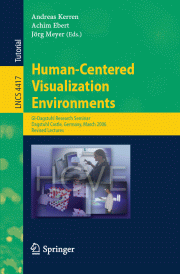Kerren, A., Ebert, A. and Meyer J. (Eds.): Human-centered Visualization Environments, volume 4417 of LNCS Tutorial, Springer, 2007: Difference between revisions
No edit summary |
No edit summary |
||
| Line 12: | Line 12: | ||
{{ISBN|978-3-540-71948-9}} | {{ISBN|978-3-540-71948-9}} | ||
== Table of Contents == | |||
*Preface | |||
*List of Contributors | |||
*1 Introduction to Human-Centered Visualization Environments (A. Kerren, A. Ebert, and J. Meyer) | |||
*2 Human-Centered Aspects (O. Kulyk, R. Kosara, J. Urquiza, and I. Wassink) | |||
**2.1 Human-Centered Approach | |||
**2.2 Usability in Human-Centered Design | |||
***2.2.1 Defining Usability | |||
***2.2.2 Evaluating Usability | |||
***2.2.3 Improving Usability | |||
***2.2.4 Usability and Information Overload | |||
**2.3 User Aims and Requirements | |||
***2.3.1 Characteristics of Good Visualizations and User Interfaces | |||
***2.3.2 Essential Elements of Successful Visualization | |||
***2.3.3 Dimensions in Visualization | |||
***2.3.4 Steps in Visualization Design | |||
***2.3.5 The Design Cycle | |||
***2.3.6 User Analysis | |||
***2.3.7 User Requirements | |||
***2.3.8 Task Analysis | |||
***2.3.9 Task Modeling | |||
***2.3.10 Designing for and with Users | |||
**2.4 Evaluation of Visualization Environments | |||
***2.4.1 Human-Centered Evaluation in Visualization Practice | |||
***2.4.2 Evaluation Methods | |||
***2.4.3 Designing Experiments | |||
***2.4.4 Challenges in Evaluation of Collaborative Visualization Environments | |||
**2.5 User Studies and a Science of Visualization | |||
***2.5.1 Survey of Information Visualization Studies | |||
***2.5.2 The Future of User Studies | |||
**2.6 Chapter Notes | |||
== References == | == References == | ||
Revision as of 13:39, 15 August 2007

Type: Softcover
Editors: Andreas Kerren, Achim Ebert, and Jörg Meyer
Pages: 403
Publisher: Springer
Publication Date: July 2007
Series: Volume 4417 of LNCS Tutorial
This tutorial book features an augmented selection of the material presented at the GI-Dagstuhl Research Seminar on Human-Centered Visualization Environments, HCVE 2006, held in Dagstuhl Castle, Germany in March 2006. It presents eight tutorial lectures that are the thoroughly cross-reviewed and revised versions of the summaries and findings presented and discussed at the seminar. After an introduction to human-centered visualization environments, the book shows the fundamental principles and methods in that area, such as human-centered aspects, interacting with visualizations, visual representations, as well as challenges and unsolved problems. The book also includes lectures on domain-specific visualization describing geographic visualization, algorithm animation, and biomedical information visualization. [Springer, 2007]
ISBN 978-3-540-71948-9
- Find this book on Amazon.com
- Find this book on Barnes & Noble
- Find this book on BooksPrice
- Find this book on Google Print
Table of Contents
- Preface
- List of Contributors
- 1 Introduction to Human-Centered Visualization Environments (A. Kerren, A. Ebert, and J. Meyer)
- 2 Human-Centered Aspects (O. Kulyk, R. Kosara, J. Urquiza, and I. Wassink)
- 2.1 Human-Centered Approach
- 2.2 Usability in Human-Centered Design
- 2.2.1 Defining Usability
- 2.2.2 Evaluating Usability
- 2.2.3 Improving Usability
- 2.2.4 Usability and Information Overload
- 2.3 User Aims and Requirements
- 2.3.1 Characteristics of Good Visualizations and User Interfaces
- 2.3.2 Essential Elements of Successful Visualization
- 2.3.3 Dimensions in Visualization
- 2.3.4 Steps in Visualization Design
- 2.3.5 The Design Cycle
- 2.3.6 User Analysis
- 2.3.7 User Requirements
- 2.3.8 Task Analysis
- 2.3.9 Task Modeling
- 2.3.10 Designing for and with Users
- 2.4 Evaluation of Visualization Environments
- 2.4.1 Human-Centered Evaluation in Visualization Practice
- 2.4.2 Evaluation Methods
- 2.4.3 Designing Experiments
- 2.4.4 Challenges in Evaluation of Collaborative Visualization Environments
- 2.5 User Studies and a Science of Visualization
- 2.5.1 Survey of Information Visualization Studies
- 2.5.2 The Future of User Studies
- 2.6 Chapter Notes
References
[Springer, 2007] Book description page [1]